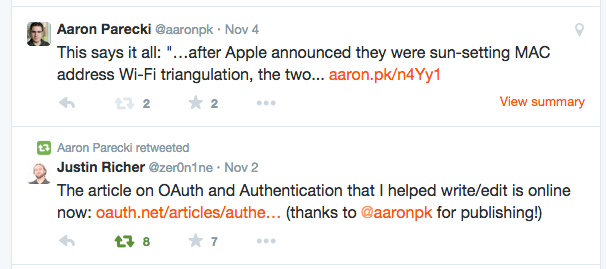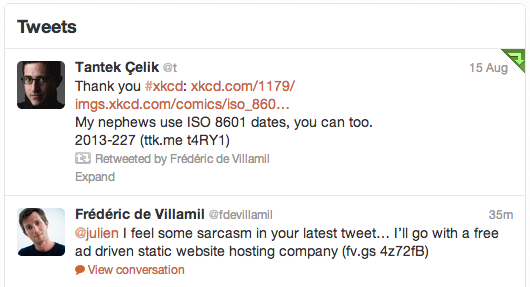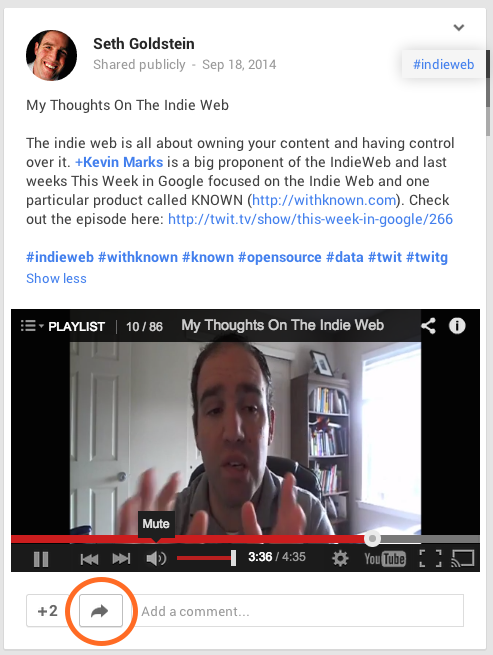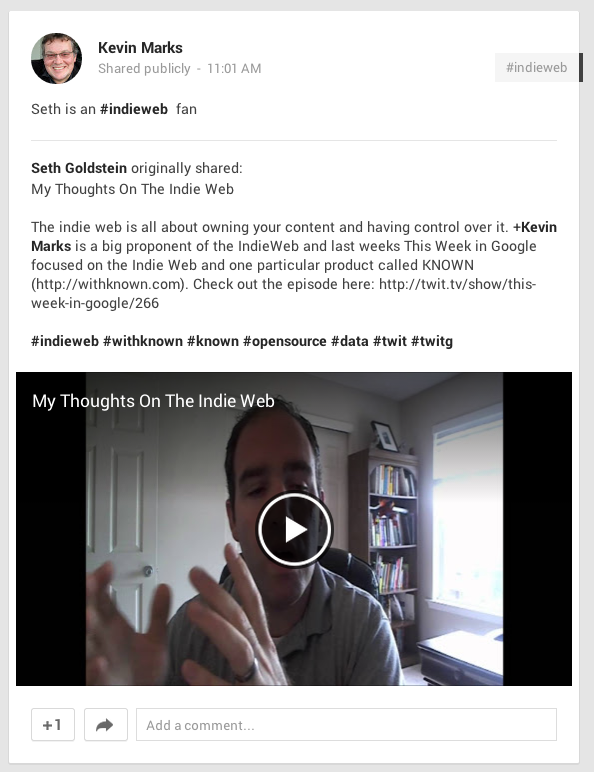repost
♺ A repost on the indieweb is a post that is purely a 100% re-publication of another (typically someone else’s) post. The act of reposting is an umbrella term that covers the general practice of republishing another post typically on the same service or silo, and sometimes across sites.
- Posting your own post on another site is syndication, see POSSE for more details.
Many silos including Tumblr, Twitter, Facebook, SoundCloud and Google+ implement reposting — see Silo Examples
For how to display others reposts of your posts on your posts (e.g. like "5 ♺"), see:
Why
Some reasons people repost content:
- Show that you agree with something without wanting to re-state it yourself. Giving credit for stating something in a way you thought was stated better than you could yourself.
- Share a post to your followers who may not be following the person you're reposting.
- Help your followers discover new people who they may not yet be following.
- Share a derivative work that was remixed from your original post.
- Share creative commons work from a Silo or from proprietary softwarw back into the Commons as HTML which increases the accessibility of the artifact.
Why implement reposting:
- Retweet from your own site. Incrementally supporting reposts, especially with POSSE to Twitter, enables you to "retweet" from your own site, rather than depending on Twitter to do so.
- This in turn ensures a copy of anything you retweet on your own site, in case the original is deleted/removed etc.
- Repost region blocked content. Some silos like Twitter and GitHub are largely or entirely blocked in some countries or regions (often due to just a fraction of the content there). By implementing reposting, you can repost posts from such sites, on your own site, for folks in other countries.(
 Tantek Çelik: Would have been useful).
Tantek Çelik: Would have been useful). - ...
Why Not
Reposting the entirety of someone else's post is closely associated with the silos Facebook, Tumblr and Twitter, as indicated by the notion above that you can "retweet from your own site". Some people are unhappy that such reposting often inadequately credits the originator of the content. For that reason, people may prefer to post a link to the original or an archived copy, possibly with an extract or quote, in order to:
- Show that you agree with something, similar to a like or bookmark, potentially saying why you like it
- Share a post to your followers, potentially saying why you are sharing it, while at the same time driving traffic to the original post; readers of your site may decide that the originator is worth following
- ...
How to Publish
Use class="u-repost-of" to indicate that the URL being linked to is what is being reposted, for example:
<span class="h-entry"> ...
<a class="u-repost-of"
href="http://anothersite.example.com/permalink47">...</a>
</span>
demonstrates an h-entry for a "repost" of http://someothersite.example.com/permalink47.
It could also be a nested h-cite
<div class="h-entry">
<div class="h-cite u-repost-of">
Repost of <a class="u-url" href="https://example.com/post">a post</a> by
<span class="p-author h-card">
<a class="u-url p-name" href="https://example.com">Author Name</a>
</span>:
<blockquote class="e-content">
<p>The post being reposted</p>
</blockquote>
</div>
</div>
The example above uses the nesting rules of microformats parsers. The u-repost-of is a property of the h-entry. The value of the u-repost-of property is the nested h-cite. Thus the u-repost-of included in the h-entry will default to the u-url of the h-cite.
This nesting is useful if the target is displayed similar to a reply-context
As with replies and likes, let the reposted URL know that you’ve linked to it by sending a webmention.
Why not u-repost?
- The trailing preposition "of" helps communicate this in the same that we have
u-in-reply-toinstead ofu-reply, andu-like-ofinstead ofu-like. - This frees up "u-repost" (and "p-repost") to actually indicate that the URL being linked is a repost itself (e.g. similar to "p-comment").
How to Display
Best practices for how to display a repost are still being worked out.
See: Challenges: Display below.
See: 2014 Repost session: repost presentation for some sketches of possible repost presentation.
IndieWeb Examples
Barry Frost
Barry Frost has been experimenting with using u-repost for reposts since at least ????-??-??, example?
Barnaby Walters
Barnaby Walters manually reposted his own article post Getting Started With microformats2 on microformats.org using WordPress and u-repost-of markup on 2014-03-05. Example(s):
Ryan Barrett
Ryan Barrett uses WordPress and the IndieWeb Press This bookmarklet to repost tweets and POSSE retweets since at least 2014-04-21. Examples:
- https://snarfed.org/2014-04-21_twitter-t-going-to-homebrew-website-club
- retweet of: https://twitter.com/t/status/458308409558040577
Aaron Parecki
 Aaron Parecki has been posting reposts on his website since 2014-10-29. Examples:
Aaron Parecki has been posting reposts on his website since 2014-10-29. Examples:
Amy Guy
Amy Guy has been able to post reposts since 2015-04-07, listed at /shares Eg:
Marty McGuire
 Marty McGuire has been posting reposts since 2016-11-11. Example:
Marty McGuire has been posting reposts since 2016-11-11. Example:
Sebastiaan Andeweg
 Sebastiaan Andeweg has reposts on his site since he imported his twitterfeed.
Sebastiaan Andeweg has reposts on his site since he imported his twitterfeed.
- On 2017-02-07, he reposted a whole article (first no-tweet), to host a copy of it in case the original would go down because of heavy traffic.
- Since 2017-02-16 he changed the way his reposts look, displaying only the first 50 words of reposted articles. This way, most tweets stay intact, but articles get shortened, making it only quotes, thus keeping copyright impact low.
- To further keep content on the original page, permalinks of reposts where redirected to the original. This would, however, make it impossible to webmention, so he removed the redirect on 2017-03-03, giving his reposts pages on his own site again.
- After some deliberation, decided on 2017-03-03 to change the reposted article from 'repost-of' to 'bookmark-of', which solved the problem of having to quote / shorten it. So: now reposts have their own url on Seblog, show all the content of the original post.
gRegor Morrill
 gRegor Morrill has posted reposts as of 2017-04-17:
gRegor Morrill has posted reposts as of 2017-04-17:
- Repost of Facebook post: https://gregorlove.com/2017/04/robert-reich-posted/
- Repost of Facebook photo: https://gregorlove.com/2017/04/repost-me-and-superman/
- Tried with text "Reposted [name]'s photo:"
Daniel Goldsmith
 Daniel Goldsmith has been reposting on his site since 2018-01-05 using nanopub.
Daniel Goldsmith has been reposting on his site since 2018-01-05 using nanopub.
Nanopub extracts data from the reposted location using XRay and stores this data in json-formatted frontmatter. In the case of tweets, the repost-intention is correctly syndicated to the twitter.com silo.
Greg McVerry =
 Greg McVerry sometimes reposts remixes of his posts as a h/t to the author who made the derivative work.
Greg McVerry sometimes reposts remixes of his posts as a h/t to the author who made the derivative work.
Add yourself!
- ...
Proto-repost examples
The following IndieWeb examples resemble reposts in appearance but are actually other simpler kinds of posts.
Tantek
 Tantek Çelik has occasionally posted pseudo-retweets to tantek.com as notes, e.g.:
Tantek Çelik has occasionally posted pseudo-retweets to tantek.com as notes, e.g.:
- 2011-06-29 http://tantek.com/2011/180/t2/ashton-kutcher-invite-vic-gundotra-hot-g
RT @scobleizer: "Ashton Kutcher [@aplusk] asked me for an invite. Hey +Vic Gundotra you got a hot property!" G+: https://plus.google.com/111091089527727420853/posts/QXD5Rsm7bNn
- POSSEd as a tweet (not retweet) : https://twitter.com/t/status/86285590655549442
And a manual photo repost from Instagram, with additional prepended text.
Other independent examples
Syracuse iSchool
Self-described as:
Information Space is where the people of the Syracuse iSchool community share their stories, ideas and thoughts about the information field. Our bloggers are students, alumni, faculty and staff.
this sounds like a reasonably independent community more than a silo.
Examples:
- 2016-08-24 What Is the Decentralized Web? 24 Experts Break it Down is a repost of an article that explicitly notes:
notably:This article is reposted from “What Is the Decentralized Web? 24 Experts Break it Down” written by 2U intern and Syracuse University iSchool Senior Mackenzie Polzin.
- "repost" notice is the first thing after the article name/title
- "em" tag/markup is used to emphasize the fact that it is a repost
- The text "This article is reposted from" is very direct (and similar in structure to POSSE text like "Originally published at:")
- hyperlink to original article being reposted, with linktext of original article name/title.
- missing "," (comma) after that hyperlink makes the subsequent "written by" ambiguous/misleading
- "written by" text should really be "reposted by"
- followed by brief profile (role, association, name) of the reposter
- by putting the repost notice first, it also shows up in "summary" views of the article as well, e.g. on the author's page.
Past Examples
Examples that used to be posted, but have been removed or are missing
Sandeep Shetty
Sandeep Shetty had been posting reposts on sandeep.io since at least 2013-06-04 (http://www.sandeep.io/35). Examples:
- http://www.sandeep.io/35
Kyle Mahan
Kara Mahan has been posting reposts on kylewm.com since at least 2014-06-10 (archived). Example:
- 2014-06-10: Archived example - repost of a tweet (Twitter note)
- POSSE native retweet: https://twitter.com/kyle_wm/status/476161871926816768
- 2014-08-08: repost of an indieweb post: https://kylewm.com/share/2014/08/09/1 (could not find archive of this URL)
- POSSE native retweet of POSSE tweet: https://twitter.com/kyle_wm/status/497920789018984448
- 2015-08-24: repost of an Instagram photo: Archived example
- POSSE photo post to Twitter (different silo than original post): https://twitter.com/kylewmahan/status/635905463377244160
- Note: cross-posted tweet of original IG photo: https://twitter.com/veganstraightedge/status/635898795004461056 - which lacks a photo because: 1) Instagram does not post cross-photos to Twitter - only URLs to the permalinks on IG, and 2) IG refuses to add Twitter-proprietary Twitter card meta tags, Twitter shows no image on that cross-post.
- Analysis: Faced with the choice of 1) native retweet of the cross-posted tweet of the original IG photo that lacks a photo, or 2) POSSE of your photo repost to Twitter *with* photo, I'm thinking 2) makes more sense, yet wonder if there's some way to connect it to the cross-posted tweet of the original IG. Tantek 17:44, 14 November 2015 (PST)
Commons Examples
Quitter se
Kara Mahan using an account on Quitter.se, reposted a note from
 Tantek Çelik:
Tantek Çelik:
- https://quitter.se/notice/3667716
- note: Javascript required to view the repost
Services
Bridgy
Bridgy sends webmentions for Facebook and Google+ reshares and Twitter retweets, as reposts. It uses class="u-repost u-repost-of" to support both the established property name and the earlier, experimental property name.
Projects
Publify
Publify is a project for hosting your own content / site.
Publify displays reposts using the original tweet data. Current used information are:
- Original author URL (in case it exists in the tweet) or link to the Twitter account.
- Original author profile picture
- Original message
- A link to the original message with the date and time of post.
Additional information are provided regarding the repost:
- Date and time of the repost.
- Author of the repost
- Short permalink to the POSSEd content.
From a visual point of view, the reposted message is displayed like most blockquotes, to enforce the citation impression.
From a markup point of view:
- the reposted message is enclosed inside a blockquote.
- the whole status is a h-entry
- the short permalink has rel="syndication"
Sessions
IndieWebCamp sessions where reposts were discussed:
- 2014/reposts - at IndieWebCamp 2014 (NYC venue)
Differentiating Reposts
Quote vs. Repost
For me reposting is about saying this entire post is interesting (http://www.sandeep.io/35) while quoting (quotation) is about curating just the relevant parts (http://www.sandeep.io/27). So this implies a UX difference. With quoting (which is just a regular post) I highlight the curated "text" (with blockquote) while with reposting I highlight a post (by showing the author, title, summary, dt-published, etc.) - Sandeep Shetty
- +1 (except for the Emphasis Exception as documented)
 Tantek Çelik
Tantek Çelik
Like vs Repost
A repost is different from like in that a like is about me liking something personally (subjective value) while a repost is about something I think will be valuable to people that follow/subscribe to my site (objective value). Liking is an emotional response (feeling). - Sandeep Shetty
- +1 this is a good distinction.
 Tantek Çelik
Tantek Çelik
Bookmark vs Repost
Bookmark obviously does not contain the full content. Is there a difference in intent? Some users clearly share (and comment) on bookmarks with the intent of sharing the bookmarked post with others. Other bookmarks could be just private "I want to find this again" notes. thoughts? – Sven Knebel
- for me, I only repost things when they are something I would have written myself, but was either better written by someone else, or I wanted to credit them for it. I post far more bookmarks than reposts, and bookmarks are a way for me to find content again, since I tag all my bookmarks. -
 Aaron Parecki
Aaron Parecki - I think the purpose of a repost (other than promoting the content) would be to preserve the content on the web. A bookmark, whether it contains a comment or is published with the intent of sharing, is still a link to external content. –
 Martijn van der Ven
Martijn van der Ven - I've recently begun using PressForward, a WordPress plugin, that allows one to scrape an entire page via bookmarklet for reposting which I'm alternately using for bookmark or read posts. The nice part is that it provides the ability (though there's currently a bug in it, so I'll try to post an example shortly once it's been remedied) to set the original URL of the content as the canonical URL and when visiting the post directly at the URL for my site, it will redirect my repost to the original page URL (after a configurable number of seconds), thus giving my site a referral ping (especially from POSSE copies which typically have just a traditional bookmark headline or short quote/snippet), while still giving the original site the ultimate credit. My post then still stands as fully readable from my back end for my personal archival/consumption purposes (who can really trust something you bookmark to still exist when you want to come back to it??), especially with highlights and other potential marginalia, but can also still receive webmentions and conversation around my post of the original article. In archive page views on my site, I typically use a "read more" tag after a paragraph or less of the original as a teaser which then forces the reader to visit the page URL which, as mentioned, forwards to the original source, so it works as a more "traditional" bookmark for other people viewing my post. Ultimately I'm heavily blurring the line between some of the types for my personal consumption while still trying to present things traditionally to outside readers. As a result, I rarely use reposts, except for extremely short content like Twitter, or use it as described by
 Aaron Parecki above. I've also begun pinging the Internet Archive/Wayback machine with all posts to save the content found for bookmarks/reposts/etc. as an additional back up. –
Aaron Parecki above. I've also begun pinging the Internet Archive/Wayback machine with all posts to save the content found for bookmarks/reposts/etc. as an additional back up. –  Chris Aldrich
Chris Aldrich
Displaying reposts of
When a post receives a webmention from a repost, it can choose to display it similar to a favoriting/liking of that post, as well as optionally displaying a number of reposts, or icons of recent reposters.
See reposts for more specifics.
Silo Examples
Twitter uses their silo specific term "retweet" for a repost, the action of posting a repost, and thus present "retweeting" and past "retweeted" verb tenses as well.
On Twitter, retweeted statuses are displayed with the original author's information in the activity stream of the reader.
Modern (2014-11-06) example screenshot of a Twitter retweet:
This in-stream Twitter retweet presentation consists of:
- a green-background white-foreground retweet icon, followed inline by
- "Aaron Parecki" (the display name of the person who retweeted the post) followed inline by
- the word "retweeted" (presumably localized to the reader's preferred language), both in smaller gray text compared to the rest of the information in the retweet.
Below that, the original tweet appears identical to how it appears on the original author's timeline, except
- if the retweeter is the logged-in viewer of the webpage, then
- the retweet icon (between the reply and favorite icons) below the original tweet appears in green, indicating that the logged-in viewer has retweeted that tweet.
2014-08-29 retweet in stream
In stream, Twitter shows the original author of the retweeted Tweet as normal, and includes text above saying "retweeted by {name}". Only the display name of the person who retweeted is shown, not the Twitter username. This can lead to confusion when reading your stream since you may not know how a tweet appeared them if you don't recognize the person's display name.
2014-06-28 retweet in stream
2013 retweet in stream
Previously, retweets in streams of the retweeter looked like:
The Most Reposted Thing
Most Retweeted
See: reposts#Most_Reposts
Tumblr
Tumblr has a notion of "reblogging", which Tumblr users tend to take reblogging quite seriously — for example it is bad form to reblog a post as a new tumblr post even if you're linking back to the original [1]
Tumblr reblog UX as of 09/03/14:
Post appears in user's dashboard. User clicks reblog button in bottom right corner of post.

Reblog window is presented showing original content and allowing user to add comment in text box. Text box can switch from WYSIWYG to HTML.
Text box also shows previous comments in it in successive blockquotes. It is possible to edit or remove this content and it will be displayed that way in the reblogging user's reblog post. While this is possible it's considered bad form to edit previous content. Tags can also be added to the reblog post. Tags are not carried over from the post that is being reblogged.

The post is then displayed in the users dashboard as a reblog and is visible in the dashboards of those following the reblogger:

Tumblr reblog persistence
A Tumblr reblog post is a copy of the original, thus even if the original is deleted, the reblog copy remains, and still refers to the (now deleted) permalink of where it was reblogged from. This is in contrast to Twitter retweets, where if the original is deleted, all the retweets disappear as well (because all they are are redirects to the original permalink, conversely the new "retweet with comment" will show the comment and a dead link preview).
Example:
- http://50thousand.tumblr.com/post/124122093511/cloud-kitten-holyshmidt-time-lapse-photo-of
- is a reblog of: http://cloud-kitten.tumblr.com/post/103017083270/holyshmidt-time-lapse-photo-of-hundreds-of
- is a reblog of dead/deleted post/tumblr http://holyshmidt.tumblr.com/post/99993211619/time-lapse-photo-of-hundreds-of-sunsets
- though the reblogger says they got it via: http://tayyface.tumblr.com/post/103014586022/holyshmidt-time-lapse-photo-of-hundreds-of
- is a reblog of: http://cloud-kitten.tumblr.com/post/103017083270/holyshmidt-time-lapse-photo-of-hundreds-of
Facebook has a notion of "share" - which means repost someone else's post.
Screenshots needed of:
- "share" UI (button? link? menu? in context of what posts?)
- "shared" post permalink and analysis of presentation
- "shared" post in stream and analysis of presentation
Google+
GooglePlus has a share UI that enables reposting of someone else's G+ post:
This gives a posting UI that allows a top comment to be added and a choice of circles to share to:
The shared post is indicated like this:
Repost.us
repost.us was a verb silo, hosting buttons and a UI for reposting articles which provided an HTML+JS snippet to embed on your own site. Example repost UI (seen once the "repost" button is clicked). Site is offline as of July 31, 2014
Cross-silo Examples
Because many silos allow for automatic cross-posting to other silos, many of them also cross-post local reposts!
Twitter to Facebook
A retweet on Twitter, auto-cross-posted by Twitter to Facebook:
This is particularly awkward when you compare what a Twitter to Facebook retweet cross-post looks like with a Twitter to Facebook tweet cross-post:
Brainstorming
Brainstorming Markup
Reposts carry a lot of data (all of the original post's traits + all the repost's traits). How can we mark them up so that all that data is captured?
Ideally we would provide reasonable fallbacks for consumers that don't know about reposts. This is made more problematic because readers' ideal fallback (full content of the original post) is different than webmention receivers' ideal fallback (something like "reposted this.").
Here's a slightly simplified example from kylewm.com.
<article class="h-entry">
<div class="e-content p-name">
<div class="u-repost-of h-cite">
<a class="p-author h-card" href="http://werd.io/profile/benwerd">
Ben Werdmüller
</a>
<div class="e-content p-name">
<p>IPFS would be a good thing for the Internet. Amber Case explains: <a href="http://techcrunch.com/2015/10/04/why-the-internet-needs-ipfs-before-its-too-late/">http://techcrunch.com/2015/10/04/why-the-internet-needs-ipfs-before-its-too-late/</a></p>
</div> <!-- .e-content .p-name -->
<a class="u-url" href="http://werd.io/2015/ipfs-would-be-a-good-thing-for-the-internet-amber"><i class="fa fa-retweet"></i> Reposted from werd.io</a>
</div> <!-- .u-repost-of .h-cite -->
</div> <!-- .e-content .p-name -->
<a class="u-url u-uid" href="https://kylewm.com/2015/10/repost-of-ben-werdmu-ller-ipfs-would-be-a-good-thing">
<time class="dt-published" datetime="2015-10-06T16:58:29-07:00">
4:58pm PDT
</time></a>
</article>
Challenges
The biggest challenge with repost is that currently it's something which is native to silo for silo posts, and nothing more. It's a challenge, because it's not clear how it makes sense in a cross-site manner.
What's the difference between a repost and just quoting/citing another article in full?
- If it's no different, then we shouldn't invent a new term for it.
- E.g. it's not "reposting" it's just just posting and quoting.
- If it's no different, then don't invent a new term for it. No distinction = does not deserve it's own term, per minimalism and simplicity principles.
- tumblr allows users to comment on a post they reblog. If this is done in microformats, does the original content go in the content area of the new post or does it go in the reply-context?
Display
See Twitter's retweet example for one way to display a repost in stream.
How should an indieweb repost be best displayed?
- In stream?
- On its permalink?
See related IndieWebCamp 2014 brainstorming session in NYC: IndieWeb Reposts
In particular:
- http://indiewebcamp.com/2014/reposts#Repost_presentation appears to have figured this out for repost permalinks, which may also work in-stream.
How should a repost of a repost be displayed?
- Should a repost of a repost show only the original post author, or also the intermediate repost author as well?
What about a repost of a repost of a repost?
- Should a repost of ... a repost show all intermediate repost authors? A repost chain?
Avoiding blogspamming
This article:
defines "blogspamming" broadly enough to potentially apply to any repost of an article post.
The challenge is, what is the best way to repost an article, without having it seem or in any way appear to be "blogspam" or "blogspamming"?
When reposting a short post, it's common to include the full post you are linking to, but the design of your site should make it clear who is the author of the content. When reposting a longer article, it's best to include only a link to the post, or make your post a quote instead of a repost. Example of a liked post that includes just a link back: https://aaronparecki.com/2020/01/31/5/
Additional discussion at: https://chat.indieweb.org/2017-02-03#t1486168081905000
and https://chat.indieweb.org/dev/2020-02-19#t1582125391496600
Copyright issues
At HWC 2017-02-14 we questioned the ethics of reposting a complete content, especially that unless explicitly stated all material fall under copyright laws, and reposting should respect this. rel-licence could be added to indicate the openness of a certain post.
Additional discussion at: https://chat.indieweb.org/2017-02-16#t1487241083379000
Attribution and use of embeds
 Scott Jack: What do you all think about how to share someone else's post from Instagram? I thought about using an embed, but I don't really want to embed Facebook trackers on my site. So I'm thinking about posting a jpg with attribution instead. Ah better, I found the person's actual website where they've posted the same photo.
Scott Jack: What do you all think about how to share someone else's post from Instagram? I thought about using an embed, but I don't really want to embed Facebook trackers on my site. So I'm thinking about posting a jpg with attribution instead. Ah better, I found the person's actual website where they've posted the same photo.
 Ana Rodrigues: I feel a bit weird about sharing someone’s instagram post without the embed. Probably because it is images and I don’t fully understand copyright/sharing rules. When it is tweets, I usually do a full screenshot of the tweet and link to the original tweet.
Ana Rodrigues: I feel a bit weird about sharing someone’s instagram post without the embed. Probably because it is images and I don’t fully understand copyright/sharing rules. When it is tweets, I usually do a full screenshot of the tweet and link to the original tweet.
History
reblogging
Perhaps the oldest form of reposting is the act of "reblogging" someone else's blog post, which typically consists of copying an entire blog post article from one site to another, keeping it intact, and not adding anything except perhaps a "reblogged from ___" bit of text at the start and/or end linking to the original from which it was reblogged.
(need screenshots of this in the wild, what a reblog looks like, what's the UX flow to reblog something)
See Also
- This was discussed in IRC on 2013-06-09, 2013-06-10
- http://sandeep.shetty.in/2012/10/social-verbs.html (lots of resources in the references section)
- Share better than Repost & Link better than Mention
- post
- reply
- reposts
- quotation
- webactions
- brigade
- 2017-11-15 Why the Emoji Recycling Symbol is Taking Over Twitter
- early example of ♺ use by Ev Williams https://twitter.com/ev/status/923901604
- 2016-11-22 Criticism/warning:
 Manton Reece Fake news and Instagram
Manton Reece Fake news and Instagram When you have to put a little work into posting, you take it more seriously. I wonder if fake news would have spread so quickly on Facebook if it was a little more difficult to share an article before you’ve read more than the headline.
- 2018-02-26 Criticism of repost as a feature: Is Sharing Bad? (refers to sharing as reposting)
One thing that both Instagram and micro.blog have in common is that neither has a sharing [reposting] feature.
- Twitter retweet regret: https://twitter.com/BuzzFeedNews/status/1153764805066420224
- "Developer Chris Wetherell says he regrets building Twitter's retweet feature: “We handed a loaded weapon to 4-year-olds.”
https://www.buzzfeednews.com/article/alexkantrowitz/how-the-retweet-ruined-the-internet?bftwnews&utm_term=4ldqpgc#4ldqpgc" @BuzzFeedNews July 23, 2019
- "Developer Chris Wetherell says he regrets building Twitter's retweet feature: “We handed a loaded weapon to 4-year-olds.”
- 2019-07-23 Buzzfeed (by Chris Wetherell who’s been to a HWC SF) : The Man Who Built The Retweet: “We Handed A Loaded Weapon To 4-Year-Olds”
“The biggest problem is the quote retweet,” Goldman told BuzzFeed News. “Quote retweet allows for the dunk. It’s the dunk mechanism.”
- Manual repost example: https://tantek.com/2020/010/t2/indieweb-community-inclusive-anarchistic-punk (and POSSE tweet: https://twitter.com/t/status/1215694008061546501)
- "Repost 2019-10-30 @rabble from https://planetary.social:
“It’s interesting to see how the #indieweb community has forged forward with an inclusive and really anarchistic punk vision of a web for all, where everyone can DIY and co-create the future.”" @Tantek Çelik January 10, 2020
- "Repost 2019-10-30 @rabble from https://planetary.social:
- thread: https://micro.blog/vasta/8409005
- "@mal You are currently programmatically re-posting every single new post from my website on yours. Not excerpting or adding context, but blatantly posting the entire text with only one small attribution link at the bottom. It’s blatant theft. Can you please stop?" @vasta February 19, 2020
- The Markup has an interesting UI with a "republish" button that presents full html of an article including Creative Commons material for quickly cutting/pasting for a repost. Example: https://themarkup.org/google-the-giant/2020/07/28/google-search-results-prioritize-google-products-over-competitors
- Example of an explicit repost guide by an artist: https://www.instagram.com/s/aGlnaGxpZ2h0OjE4MDc3MTY1MDgwMjA4NjMy
- viral
- Draucker, F. & Collister, L. B., (2015) “[Managing Participation through Modal Affordances on Twitter”, Open Library of Humanities 1(1), p.e8. doi: https://doi.org/10.16995/olh.21
- an academic article about the differences between the original textual retweet on Twitter and the more automated retweet button.
- Criticism: 2019-07-23 BuzzFeed: The Man Who Built The Retweet: “We Handed A Loaded Weapon To 4-Year-Olds” / The button that ruined the internet — and how to fix it.
- ^ Criticism of article: the journalism there is a bit lazy. No mention of prior art, Tumblr’s reblog, that had no similar negative impact








